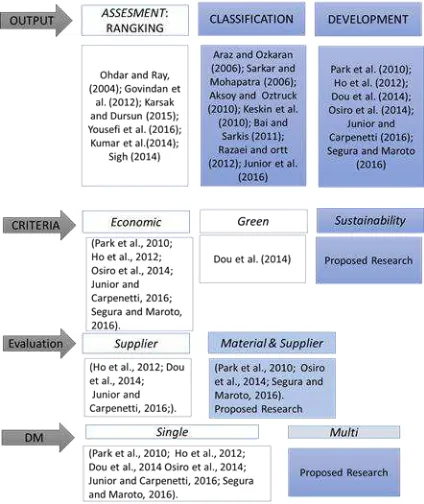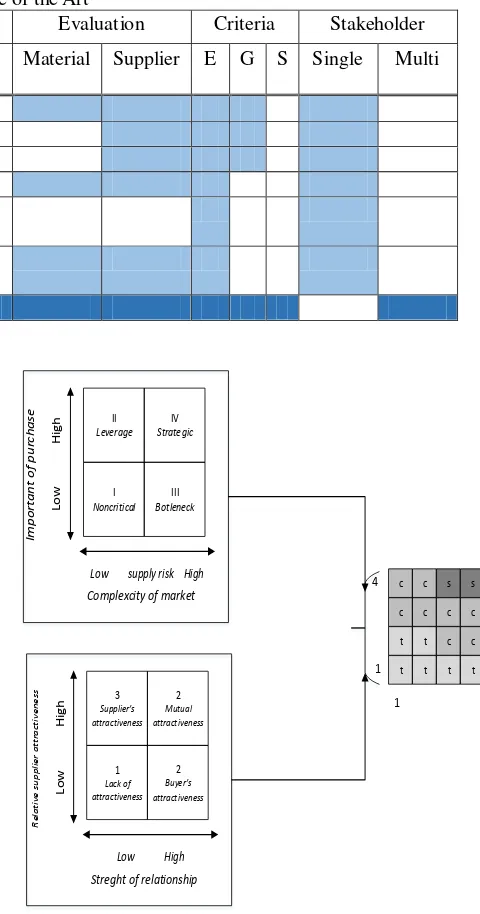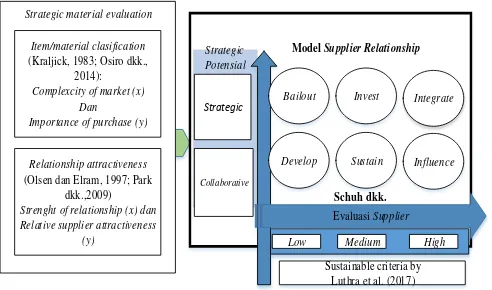Design of a Framework for Strategic Supplier
Evaluation Decision
Putri Mety Zalynda†
Industrial Engineering and Management Doctoral Program Industrial Technology Faculty
Bandung Institute of Technology, Bandung, Indonesia Engineering Faculty
Universitas Pasundan
Tel: (+62) 250 9164, Email: [email protected] Rajesri Govindaraju
Industrial Technology Faculty
Bandung Institute of Technology, Bandung, Indonesia Tel: (+62) 250 9164, Email: [email protected]
Andi Cakravastia Radja Industrial Technology Faculty
Bandung Institute of Technology, Bandung, Indonesia Tel: (+62) 2509164, Email: [email protected]
Kadarsah Suryadi Industrial Technology Faculty
Bandung Institute of Technology, Bandung, Indonesia Tel: (+62) 250 9164, Email: [email protected]
Abstract. The supplier evaluation process is a decision problem that has many criteria and goals that contain many qualitative and quantitative factors. So various multi criteria decision making (MCDM) techniques are widely used for supplier evaluation process. The process of evaluating and improving the performance of suppliers is very important to measure the effectiveness of management. The measurement and evaluation of the current system performance is indispensable to the organization for sustainable organizational growth. This research will make a framework of decision making to evaluate strategic suppliers. Output from evaluation of strategic supplier performance assessment considering sustainability criteria. Most research in evaluating only considers the assessment of supplier performance alone. The contribution of this research is to make a model of strategic supplier decision evaluation that considers not only the assessment on the supplier's performance but also how the assessment of the items supplied. The results of this study will be used to help automotive companies evaluate strategic supplier performance
Keywords: strategic supplier, evaluation, decision making, sustainability.
1. INTRODUCTION
Decision support system (DSS) is a computer-based system that uses data and analysis models as a major component to help make decisions in solving complex problems that are impossible to do with manual calculations. The decision-making model is a tool for decision makers to make future plans using qualitative or quantitative data.
The impact of collaboration, among others, is that the company restructures its relationships with suppliers by involving them as strategic suppliers. This results in a change in the division of labor between the organization (buyer) and the supplier (Helper, 1993). Changes that occur, among others, organizations (buyers) and suppliers jointly involved in product development activities and manufacturing processes. In addition, the impact of these changes leads to the organization (buyers) and suppliers, together streamline production, improve supplier skills, as well as coordinate and integrate components and products flowing from suppliers to customers in order to reduce development time, improve quality and reduce costs so as to release products quickly (Osiro et al., 2014). Therefore, suppliers to be selected as strategic suppliers must be innovative, competent and competent (Sheth and Sharma, 1999).
The process of evaluating and improving supplier performance is critical to measuring management effectiveness for sustainable organizational growth (Osiro et al., 2014). Through the supplier evaluation process will be identified improvement measures, so that will be obtained the performance of suppliers that can help improve the competitiveness of the organization (Kumar et al., 2014).
Now days, the criteria of evaluating the supplier has grown wider than the old (traditional) criteria of quality, cost, delivery, becoming criteria that take into account the sustainability factors of triple bottom line approach that is, economic, environmental, social (Kumar et al., 2014; Liou et al ., 2014; Hasemy et al., 2012; Govindan et al., 2014; Amindoust et al., 2012). These conditions make the evaluation more complex. Therefore, the study of
decision-making framework to evaluate relationships with
responsible and sustainable suppliers.
This paper is organized as follows: Section 2 provided a literature, about: background supplier evaluation. Section 3 presents about taxonomic evaluation supplier and state of the art research. Section 4 Methodology. Finally we conclude design framework in Section 5.
2. SUPPLIER EVALUATION
Many authors have proposed the problem of decision making in supplier evaluation. The selection and evaluation of supplier performance is a very important factor to build strategic supplier relationships. In fostering strategic suppliers, industries need assessment processes ranging from supplier selection, evaluation and development performance (Azania et al., 2012).
2.1 Decision Making Technique
Decision making technique in supplier's evaluation research on supplier performance evaluation was done by
Araz and Ozkaran (2006), Sarkar and Mohapatra (2006), Aksoy and Oztruck (2010), Park et al. (2010), Bai and Sarkis (2011), Yousefi et al. (2016), Ohdar and Ray (2004), Keskin et al. (2010), Govindan et al. (2012), Rezaei and Ortt (2012), Ho et al. (2012), Akman (2014), Dou et al. (2014), Kumar et al. (2014), Osiro et al. (2014), Sigh (2014), Karsak and Dursun (2015), Junior and Carpenetti (2016), Luthra et al. (2016), Segura and Maroto (2016). Of the twenty-one studies, the first six studies used a single method, other studies integrating the DM technique called the hybrid method approach.
2.2 Dimensions of Supplier Evaluation
Osiro et al. (2014), decision-making relating to action on suppliers depends on the dimensions of short-term and long-term performance evaluation of suppliers, as well as on the type of items to be supplied. Sarkar and Mahopatra (2006) define two important dimensions to assess suppliers' ability, ie performance to measure short-term capability and capability to measure long-term ability. Further research Kumar et al. (2014) did the same thing as Sarkar and Mahopatra (2006), Park et al. (2010) adds with the relationship dimension. Ho et al. (2012) sees performance and importance, while Rezaei and Ortt (2012) research looks at the dimensions of capability and willingness. Dou et al. (2014), Osiro et al. (2014), and Junior and Carpenetti (2016) see only the performance dimensions, while Segura and Maroto (2016) see from the point of critical performance and strategic performance and research on other supplier evaluations does not specifically define performance and capability dimensions.
2.2 Evaluation Criteria
Based on previous research, the supplier's evaluation criteria has been developed from traditional criteria, quality,
cost, delivery, this research proposes sustainability criteria
(economic, environment and social). In the preliminary studies that have been conducted, most researchers at the
stage of measuring performance evaluation and
development still use the criteria cost, quality, delivery, criteria are part of the economic criteria (Ohdar and Rey, 2004; Araz and Ozkaran, 2006; Sarkar and Mohapatra, 2006; Aksoy and Oztruck, 2010; Park et al., 2010; Keskin et al., 2010; Bai and Sarkis, 2011; Ho et al., 2012; Rezaei and Ortt, 2012; Osiro et al., 2014; Sigh, 2014; Karsak and Dursun, 2015; Junior et al., 2016, Yousefi et al., 2016, Segura and Maroto, 2016), only research Govindan et al. (2012), Kumar et al. (2014) and Luthra et al. (2016) using sustainability criteria for triple bottom line approach, economic, environmental and social. In order to compete and continue in the future, environmental and social criteria
need to be addressed. Accordingly, this research proposes
2.3 Supplier Evaluation Output
The results of previous studies of suppliers' evaluations are in the form of rankings based on supplier performance evaluations (Ohdar and Ray, 2004; Govindan et al., 2012; Karsak and Dursun 2015; Yousefi et al., 2016), ranking and causal relationships of the ranking criterion (Kumar Et al., 2014), rank and demand allocation (Sigh 2014), supplier classification / segmentation (Araz and Ozkaran, 2006; Sarkar and Mohapatra, 2006; Aksoy and Oztruck, 2010; Park et al., 2010; Keskin et al., 2010; Bai and Sarkis, 2011; Rezaei and Ortt, 2012), classification to follow-up development to be undertaken (Ho et al., 2012; Dou et al., 2014; Osiro et al., 2014; Junior et al., 2016; Segura and Maroto, 2016).
Many researchers conduct an evaluation by simply looking at the performance of the supplier. Researchers such as Park et al (2010) and Osiro et al. (2014) not only see evaluation of suppliers but also evaluate material / items. This research proposes evaluation for items and suppliers.
3. State of The Art
Based on literature studies that have been done, it can be made taxonomic research supplier evaluation (Figure 1). Based on literature studies that have been done, 1. Output Evaluation of suppliers are as follows:
a) The order/rank of suppliers based on supplier
performance evaluations.
b) Assessment, then classifies by item or supplier).
c) Conduct assessment, grouping so as to develop according to clustering and evaluation results.
2. Current criteria for selecting suppliers and evaluating suppliers have grown wider than the traditional criteria of quality, cost, and delivery, being criteria that take into account the sustainability factors of the triple bottom line approach, economic, environmental, and social.
3. Supplier assessment:
a. Only performance supplier evaluation b. Material and supplier assessment.
4. Decision makers in decision-making models can be single or multiple decision makers. (Single or multi stakeholder). Multi Stakeholder pay attention to
who/which departments are interested or as
stakeholders in evaluating suppliers.
The evaluations up to the stage of development were carried out by Park et al. (2010), Ho et al. (2012), Dou et al. (2014), Osiro et al. (2014), Junior and Carpenetti, (2016), Segura and Maroto, (2016). This research will evaluate the strategic supplier up to the development stage. Therefore the next study will only focus on suppliers who do evaluation until the development stage. The position of
research on other research on supplier evaluation for development can be seen in table 1.
Finally, none of the research findings on assessments to be reviewed will be carried out until the development stage by considering sustainability criteria, where decisions are multi stakeholders.
Figure 1: Taxonomic supplier evaluation research 4. Methodology
The purpose for supplier development, this research follows: first to determine strategic importance of material; second to establish the attractiveness of relationship between buyer and supplier; third evaluate the supplier with sustainability.
4.1 Strategic Item Evaluation
Strategic item evaluation is done as research by Kraljic (1983) and followed by Park et al (2009); Osiro et al. (2014). Table 2 show the criteria for strategic item evaluation. The set of criteria used for item classification model proposed by Kraljic (1983). Classification item illustrated in figure 3. On this paper non-critical items can be ignored
4.2. Buyer-Supplier Relationship Evaluation
The relationship attractiveness is determined by relative attractiveness of supplier and the strength relationship. Buyer-Supplier relationship evaluation proposed by Ollsen and Elram (1983).
4.3. Supplier Evaluation
sustainability proposed by Luthra et all (2016). According to these evaluation supplier divided into low, medium, high performance supplier.
Figure 2. Methodology Table 1 State of the Art
No
Author Type of Supplier Evaluation Criteria Stakeholder Supplier Strategic 5 Junior & Capenetti
(2016)
6 Segura & Moroto (2016)
7 Research
5. CONCLUCION
5.1 Framework strategic material evaluation
Framework strategic material evaluation proposed by Park et al. (2009). The result of strategic material evaluation is divided into 3 groups of relationship, transactional, collaborative, and strategic (figure 3).
5.2 Sustainable supplier evaluation
However, most researchers focused mainly on economic or green supplier problems. Only a few researchers focused on sustainable supplier evaluation decisions (Luthra et all. 2017). Criteria sustainability in this research (Luthra et all. 2017):
1. Economic: price of product, profit on product, quality of product, flexibility, technological & financial capability, production facilities and capability, production facilities and capacity, delivery and service, lead time required, transportation cost.
2. Environmental: environmental management system, green design and purchasing, green manufacturing, green management, green packing and labeling, waste management and pollution prevention, environment cost, environmental competencies, green R & D and innovation.
Output from performance supplier evaluation, supplier divided into three group performance: low, medium, high.
5.3 Supplier Development Phase
The evaluation of a supplier’s performance happens at least
two distinct moment in the supplier management process. First, during the supplier selection phase. In the second moment, the supplier development phase. The supplier evaluation is conducted so that some management practice can be planned and implemented aiming improving the performance capabilities of the supplier so as to better fulfill the supply needs (Osiro et al., 2014). This paper is second phase
A supplier development is determined by two axis. One is strategic material (y axis): collaboration and strategic and the other is the performance supplier evaluation (x axis): low, medium, high. And then supplier are divided into six relationship group: develop, sustain, influence, mitigate, bailout, invest, integrate. This group adopted from framework true SRM by Schuh et al. (2012).
Figure 4 proposed design Framework for strategic supplier evaluation decision. Supplier Selection Based on Self-organizing Map Neural Network and Multi Criteria Decision Making Approaches, Procedia-Social and Behavioral Sciences, 65, 879–884.
Aksoy, A. dan Oztruck, N. (2011), Supplier Selection and Performance Evaluation in Just In Time Production
Environments: Expert Systems with Applications, 38, 6351–6359.
Amindoust, A., Ahmed, S., Saghafinia, A., dan Bahreininejad, A. (2012): Sustainable Supplier Selection: A ranking Model Based on Fuzzy Inference System, Journal Applied Soft Computing, 12, 1668– 1677.
Araz, C.dan Ozkarahan, I. (2007): Supplier Evaluation and Management System for Strategic Sourcing Based on a New Multicriteria Sorting Procedure, Int. J. Production Economics 106, 585–606.
Asmus. D dan Griffin. J. (1993): Harnessing The Power of Your Suppliers, McKinsey Quarterly, 3, 63-78.
Bai, C dan Sarkis, J., (2011): Evaluating Supplier Development Programs with a Grey Based Rough Set Methodology, Expert Systems with Applications, 38, 13505–13517.
Bai, Chunguang dan Sarkis, J. (2010): Integrating Sustainability into Supplier Selection with Grey System and Rough Set Methodologies, International Journal Production Economics, 124, 252–264.
Briers, Michael BCom (Tas) PhD, Cuganesan. S., Fuzzy Multi-Criteria Decision Framework for Sustainable Supplier Selectionwith Incomplete Information, Computers in Industry, 62, 164–174.
Dou dkk. (2014): Evaluating Green Supplier Development Programs with a Grey-Analytical Network Process-based Methodology, European Journal of Operational Research, 233, 420–431
Dou, Y., Zhu, Q., dan Sarkis, J., (2014): Evaluating Green Supplier Development Programs with a Grey-Analytical Network Process-Based Methodology, European Journal of Operational Research, 233, 420–431.
Govindan, K., Khodaverdi, R. dan Javarian, A. (2013): Fuzzy Multi Criteria Approach for Measuring Sustainability Performance of a Supplier Based on Triple Bottom Line Approach, Journal of Cleaner Production, 47, 345-354.
Hasemi, S. H., Karimi, A., dan Tavana, M. (2014): An Integrated Green Supplier Selection Approach with Analytic Network Process and Improved Grey relational analysis, International Journal Production Economics, http://dx.doi.org/10.1016/j.ijpe.2014.09.027.
(Olsen dan Elram, 1997; Park dkk.,2009)
Strenght of relationship (x) dan Relative supplier attractiveness
IPA to Eevaluate Supplier’s Performance: Multiple
regression analysis and DEMATEL Approach, Expert Systems with Applications, 39, 7102–7109.
Lima-Junior, F.R. dan Carpinetti, L.C.R., (2016): Combining SCORs Model and Fuzzy TOPSIS for Supplier Evaluation and Management, International Journal .Production Economics, 174, 128–141
Karsak, E. E. dan Dursun, M. (2014): An Integrated Supplier Selection Methodology Incorporating QFD and DEA with Imprecise Data, Expert Systems with Applications, 41, 6995–7004.
Karsak, E.E. dan Dursun, M., (2015): An Integrated Fuzzy MCDM Approach for Supplier Evaluation and Selection, Computers & Industrial Engineering, 82, 82–93.
Keskin, G.A., Ilhan, S., dan Ozkan, C., (2010): The Fuzzy ART Algorithm: A Categorization Method for Supplier Evaluation and Selection, Expert Systems with Applications, 37, 1235–1240.
Kraljic, P., (1983): Purchasing Must Become Supply Management, Harvard Business Review, 109-117
Kumar, P., Bhattacharya, A., dan Ho, William (2014): Strategic Supplier Performance Evaluation: A case-based action Research of A UK Manufacturing Organization, International Journal Production
Economics, http://dx.doi.org/
10.1016/j.ijpe.2014.09.021.
Liou, J. J. H., Chuang, Y. dan Tzeng Gwo-Hshiung (2014): A fuzzy Integral-based Model for Supplier Evaluation and Improvement, Journal Information Sciences, 266, 199–217.
Liou, J.J.H., Chuang, Y. dan Tzeng, G., (2014): A Fuzzy Integral-Based Model for Supplier Evaluation and Improvement, Information Sciences, 266, 199–217. Luthra,S., Govindan, K., Devika Kannan, D., Mangla,
S.C. dan Garg, C.P. (2016): An Integrated Framework for Sustainable Supplier Selection and Evaluation Ohdar, R. dan Ray, P.K., (2004): Performance Measurement
and Evaluation of Suppliers in Supply Chain: An Evolutionary Fuzzy-Based Approach, Journal of Manufacturing Technology Management, 15, 723–734. Osiro, L., Lima-Junior, F.R., dan Carpinetti, L.C., (2014): A
Fuzzy Logic Approach to Supplier Evaluation for Development, International Journal Production Economics, 153, 95–112.
Park, J., Shin, K., Chang, T. dan Park, J., (2010): An Integrative Framework for Supplier Relationship Management, Industrial Management & Data System, 110, 495-515.
Rezaei, J. dan Ortt, R. (2013): Production, Manufacturing and Logistics: Multi-Criteria Supplier Segmentation Using a Fuzzy Preference Relations Based AHP, European Journal of Operational Research, 225, 75–84.
Rezaei, J. dan Ortt, R. (2013): Supplier Segmentation Using
Fuzzy Logic, Industrial Marketing Management, 42, 507– 517.
Sarkar, A. dan Mohapatra, P.K.J., (2006): Evaluation of Supplier Capability and Performance: A Method for Supply Base Reduction, Journal of Purchasing & Supply Management, 12, 148–163.
Schuh, C., Strohmer, M.F., Easton, S., Hales, M. dan Triplat, A. (2012): Supplier Relationship Managemet: How to Maxime Supplier Value and Opportunity, Springer, Berlin. Segura, M. dan Maroto, C. (2017): A Multiple Criteria Supplier Segmentation Using Outranking And Value Function Methods, Expert Systems With Applications 69, 87–100.
Sheth, J.N. dan Sharma, A. (1999): Supplier Relationships: Emerging Issues and Challenges, Industrial Marketing Management, 26 (2), 91–100.
Singh, A.,(2014): Supplier Evaluation and Demand Allocation Among Suppliers in a Supply Chain, Journal of Purchasing & Supply Management, 20, 167–176. Yousefi, S., Shabanpour, H., Fisher, R. dan Saen, R.F.,


